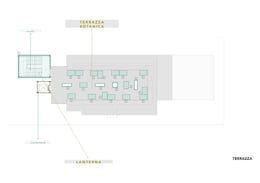Login
Registered users

The visitors' center and pedestrian walkway on the construction site for the La Maddalena tunnel - Chiomonte (TO) The project, winner of the competition helded by TELT, is conceived around the modular use of 27 shipping containers that form and articulate a volume with a large cantilever, wide windows and views of the landscape and the construction site. An essential architecture, reversible, recyclable, modular and quick to assemble. The building, which is proposed as an additional attraction for the territory, uses the geothermal energy intercepted in the excavationof the tunnel, involves visitors, from the very beginning of their visit, in the environment in which the worksite activities take place through a constantly evolving narrative. The exposition have been designed using innovative technologies and focus on the themes of large infrastructures: sustenability, excavation techniques, impact on the territory, environmental protection and on the roof, among native plants, there is an educational path on biodiversity. The concept of the new building, which rises in the Chiomonte construction site area, one of the main sites for the construction of the works on the Italian side of the tunnel of the New Turin-Lyon railway line, starts from a solid, compact volume composed of 27 Freight Shipping Containers stacked one on top of the other, according to the methods used in ports. The choice of containers, recycled, reversible, removable, easy to assemble and dismantle, was implemented to refer to the very essence of the construction site and as an architectural and sustainable choice. The shifting of volumes, created by eliminating some of the container walls, staggering some of the container blocks, and creating a 6-metre cantilevered roof to protect the entrance, are the key elements in the architectural interpretation of the work. The front towards the current entrance to the tunnel is raised with an empty container structure to allow for the direct connection of the building with a future walkway that, developing above the current entrance, will allow for movement along a protected scenic route from which it will be possible to see, live, the main processing areas below. The entire path, as well as the access to the building, is designed to allow accessibility to persons with mobility disabilities. The entrance foyer is the first point of contact with the history of the project: an immersive projection system acts as a trailer for the entire visit and opens up to the exhibition route and the changing room area, where visitors can equip themselves with the appropriate individual safety equipment, such as helmets, boots, and waistcoats for visiting the site. The visiting experience is conceived as a continuous route that begins through the double cross-ramp staircase where the first information about the history and evolution of the project can be found. The containers facing the construction site have been emptied to create a double-height space, hosting the conference room, with a large window allowing views from a privileged height. The conference hall, from which, the visitors can directly view the construction site through the large double-height window, is the heart of the building and the most dynamic and flexible space; designed to work in parallel with the first exhibition room, making its use variable according to specific needs. On a modulated space of approx. 560 m² dealt with issues related to the construction site and the territory: framing in the corridors of international transport, history and current events, excavation technologies, geology, landscape and ecology, environmental protection. The panoramic path is made of welded meh floring, with a steel mesh railing and a roof made with corrugated metal sheet, all elements linked to the construction site, easy to manage and quick in their combination and assembly. The volume is completed with two special elements: a panoramic viewpoint made from a customised container and a digital lantern on top of the staircase, realised with a grid of LED modular cells that projects the countdown of excavation of the new tunnel. One of the project's sustainability goals is to reduce the building's energy requirements by exploiting geothermal heat, which provides an important source of energy, through heat exchangers or heat pumps that use water intercepted by the excavation. The overall system is supported by an inner thermal insulation and the adoption of green roof systems, which mitigate peak temperatures. The building is also equipped with an intelligent control system for managing energy consumption, with humidity sensors, lighting detectors etc. The large glass openings in the external facades allow for a supply of natural light, which contributes to the reduction of electricity consumption, given the prevalent use during daylight hours. The building is equipped with rainwater collectors, allowing the reuse of water for restrooms and irrigation of the greenery.






























Cristiana Catino began her career with Andrea Bruno and Renzo Piano and was founder/partner of Negozio Blu. Since 1995 she has specialised in bio-architecture and in 2016 created ACC Naturale Architettura. Her most significant projects include Green Pea, the first green retail center (Turin 2020), the Hotel Fontanafredda (Alba 2017-), the socio-cultural centre Workout Pasubio, Parma (2016 competition), restoration, interior and retail design projects and urban/landscape redevelopment.
PlaC is an architecture/urbanism firm that develops regeneration projects on different scales; its work is the result of collaborative processes, with a critical approach about city-territory, construction and design. PlaC focuses on emphasizing existing qualities to evolve in something unexpected; strengthening of identities, adaptability of program and flexibility are the main tools. PlaC has developed projects in Italy and abroad and got awarded in different international competitions.